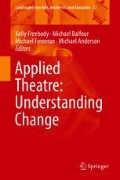Abstract
Evaluation experts commonly request program designers to make explicit their ‘theory of change’ so as they can design appropriate methods to investigate the impact of the program. If this theory and its internal ‘program logic’ is not provided, the evaluators must employ their own presumptions about what to investigate. Those devising applied drama interventions may prefer the language of connoisseurship, which conjures the qualitative notion of appreciation. It can be hard to imagine how a collective, aesthetic, and emergent experience can be evaluated quantitatively, let alone by outsiders who may not be oriented to read the aesthetic modalities of the intervention. Applied drama practitioners may fear that an impact study conducted by an external evaluator could miss the value of their work, and judge it against inappropriate standards. What if they measure the wrong things, or fail to value the essential features of the process? Will this then devalue the work, and potentially leave people to presume that applied theatre interventions are simply a form of infotainment? However, to resile from rigorous evaluation is to miss an opportunity to enhance influence. This may require a transdisciplinary effort to make applied drama methods both visible and measurable. It may also require positioning the evaluator as a partner in the co-construction and sharing of knowledge, in this harnessing the tradition of developmental evaluation. A framework is proposed to assist practitioners working towards a creative-evaluative partnership when using applied drama as a pedagogy for social change.
Access this chapter
Tax calculation will be finalised at checkout
Purchases are for personal use only
References
Betancourt, T., & Khan, K. (2008). The mental health of children affected by armed conflict: Protective processes and pathways to resilience. International Review of Psychiatry, 20(3), 317–328.
Blum, R., & Mmari, K.N. (2005). Risk and protective factors affecting adolescent reproductive health in developing countries. Retrieved July 3, 2017 from http://apps.who.int/iris/bitstream/10665/43341/1/9241593652_eng.pdf
Bond, L., Butler, H., Thomas, L., Carlin, J., Glover, S., Bowes, G., & Patton, G. (2007). Social and school connectedness in early secondary school as predictors of late teenage substance use, mental health, and academic outcomes. Journal of Adolescent Health, 40(4), 357–359.
Cahill, H. (2010). Re-thinking the fiction/reality boundary: Investigating the use of drama in HIV prevention projects in Vietnam. RIDE, 15(2), 152–172.
Cahill, H. (2011a). Drama for deconstruction. Youth Theatre Journal, 25(1), 16–31.
Cahill, H. (2011b). Transdisciplinary practice: Using systems thinking tools to generate new stories about HIV. Drama Australia (NJ), 35, 15–33.
Cahill, H. (2012). Form and governance: Considering the drama as a ‘technology of the self’. Research in Drama Education: The Journal of Applied Theatre and Performance, 17(3), 405–424.
Cahill, H. (2014a). Promoting critical thinking within the drama: Using theory to guide practice. Applied Theatre Research, 2(2), 151–164.
Cahill, H. (2014b). Withholding the personal story: Using theory to orient practice in applied theatre about HIV and human rights. Research in Drama Education: The Journal of Applied Theatre and Performance, 19(1), 23–38. https://doi.org/10.1080/13569783.2013.872427.
Cahill, H., & Coffey, J. (2015). Positioning, participation and possibility: Using post-structural concepts for social change in Asia-Pacific youth HIV prevention. Journal of Youth Studies, 19(4), 1–9.
Cahill, H., & O’Connor, P. (2011). Of stances and territories: Interdisciplinary, drama and social change. Drama Australia (NJ), 35, 4–11.
Catalano, R. F., Haggerty, K. P., Oesterle, S., Fleming, C. B., & Hawkins, J. D. (2004). The importance of bonding to School for Healthy Development: Findings from the social development research group. Journal of School Health, 74(7), 252–261.
Cross, W. F., Seaburn, D., Gibbs, D., Schmeelk-Cone, K., White, A. M., & Caine, E. D. (2011). Does practice make perfect? A randomized control trial of behavioral rehearsal on suicide prevention gatekeeper skills. Journal of Primary Prevention, 32, 195–211.
Dishion, T. J., McCord, J., & Poulin, F. (1999). When interventions harm - peer groups and problem behaviour. American Psychologist, 54(9), 755–764.
Eisner, E. (1985). The educational imagination: On the design and evaluation of school programs (2nd ed.). New York: Macmillan.
Holley, K. (2009). Understanding interdisciplinary challenges and opportunities in higher education. ASHE Higher Education Report, 35(2), 1–131.
Hyunsan, C., Hallfors, D. D., & Sanchez, V. (2005). Evaluation of a high school peer group intervention for at-risk youth. Journal of Abnormal Child Psychology, 33(3), 363–373.
La Greca, A., & Silverman, W. (2009). Treatment and prevention of posttraumatic stress reactions in children and adolescents exposed to disasters and terrorism: What is the evidence? Child Development Perspectives, 3(1), 4–10.
McNeely, C. A., Nonnemaker, J. M., & Blum, R. W. (2002). Promoting school connectedness: Evidence from the National Longitudinal Study of adolescent health. Journal of School Health, 72(4), 138.
O’Dea, J. (2000). School-based interventions to prevent eating problems: First do no harm. Eating Disorders, 8(2), 123.
Patton, M. Q. (2002). Qualitative research and evaluation methods (3rd ed.). Thousand Oaks: Sage Publications.
Patton, M. Q. (2006). Evaluation for the way we work. Nonprofit Quarterly, 13(1), 28–33.
Resnick, M., Bearman, P., & Blum, R. (1997). Protecting adolescents from harm: Findings from the National Longitudinal Study on adolescent health. JAMA, 278(1), 823–832.
Schön, D. A. (1999). The reflective practitioner: How professionals think in action (1999th ed.). Aldershot: Ashgate.
Author information
Authors and Affiliations
Corresponding author
Editor information
Editors and Affiliations
Rights and permissions
Copyright information
© 2018 Springer International Publishing AG, part of Springer Nature
About this chapter
Cite this chapter
Cahill, H. (2018). Evaluation and the Theory of Change. In: Freebody, K., Balfour, M., Finneran, M., Anderson, M. (eds) Applied Theatre: Understanding Change. Landscapes: the Arts, Aesthetics, and Education, vol 22. Springer, Cham. https://doi.org/10.1007/978-3-319-78178-5_11
Download citation
DOI: https://doi.org/10.1007/978-3-319-78178-5_11
Published:
Publisher Name: Springer, Cham
Print ISBN: 978-3-319-78177-8
Online ISBN: 978-3-319-78178-5
eBook Packages: EducationEducation (R0)

